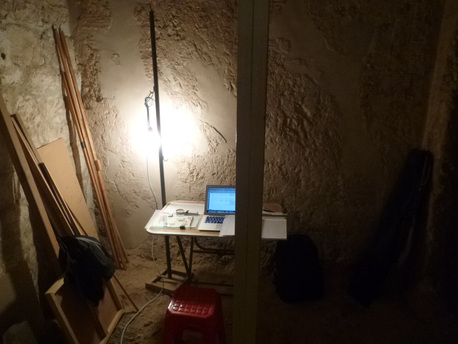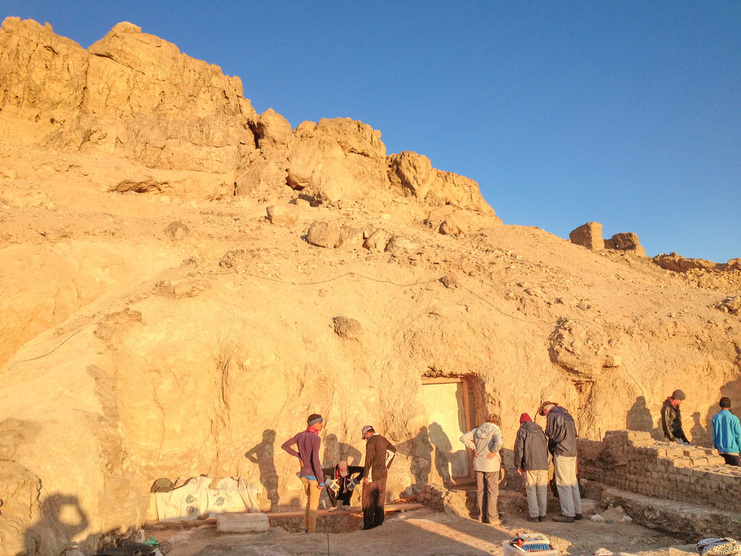Dr. Malcolm Choat is an Associate Professor in the Department of Ancient History and Director of the Macquarie University Ancient Cultures Research Centre.
 [View of Western Thebes from Luxor on the East bank: the “Mountain of Djeme,” as it was known in Late Antiquity, can be seen in the background. Photo: Malcolm Choat]
[View of Western Thebes from Luxor on the East bank: the “Mountain of Djeme,” as it was known in Late Antiquity, can be seen in the background. Photo: Malcolm Choat] In early January 2015, I spent a week in Luxor, working with the members of the Macquarie Theban Tombs project on the excavation of TT ("Theban Tomb") 149 in the Pharaonic necropolis on the West Bank in Thebes. I found Luxor and its inhabitants welcoming and friendly as always, although the continued lack of tourists since the 2011 revolution has increased the hardships faced by the community, who were heavily dependent on this source of income.
The Macquarie Theban Tombs project, led by Assoc. Prof. Boyo Ockinga and Dr Susanne Binder from the Department of Ancient History at Macquarie University, Sydney, is investigating a series of New Kingdom tombs on Dra’ abu el-Naga, in the North of the Theban necropolis. TT 149 was once the tomb of Amenmose, Royal Scribe of the Table of the Lord of the Two lands and Overseer of Huntsmen of the Estate of Amun. In Late Antiquity, the tomb, along with TT233, the adjoining tomb to the South, and a number of other tombs on the North end of Dra’ abu el-Naga, were reused by monks, who formed a monastic community on the hillside overlooking the village (whose name is not known) in the mortuary Temple of Sety I, about 10 minutes walk east.
The Macquarie Theban Tombs project, led by Assoc. Prof. Boyo Ockinga and Dr Susanne Binder from the Department of Ancient History at Macquarie University, Sydney, is investigating a series of New Kingdom tombs on Dra’ abu el-Naga, in the North of the Theban necropolis. TT 149 was once the tomb of Amenmose, Royal Scribe of the Table of the Lord of the Two lands and Overseer of Huntsmen of the Estate of Amun. In Late Antiquity, the tomb, along with TT233, the adjoining tomb to the South, and a number of other tombs on the North end of Dra’ abu el-Naga, were reused by monks, who formed a monastic community on the hillside overlooking the village (whose name is not known) in the mortuary Temple of Sety I, about 10 minutes walk east.
 [View east from TT233 and 149. The Temple of Sety I can be seen at the edge of the cultivated zone in the valley below. Photo: Malcolm Choat]
[View east from TT233 and 149. The Temple of Sety I can be seen at the edge of the cultivated zone in the valley below. Photo: Malcolm Choat] In the late Roman and early Islamic period, West Thebes was as a major centre of Christian monasticism, with large communal monasteries, smaller communities, and hundreds of anchorites living in the tombs. Excavations in TT233 and 149 have revealed extensive remains of the monks who dwelt there: an oven was built between the tombs; graffiti were written in the broad hall of TT233; mud brick walls, a paved floor, and stairs leading down into the tomb were put in the courtyard of 149. As well as that, a large textual assemblage in Greek and Coptic has been found in the tomb. Circa 80 Coptic ostraca and c. 60 Greek and Coptic papyri were found in TT233, and this season, we found another 80 Coptic and Greek papyri in the courtyard of TT 149, along with a small number of Coptic ostraca. Among the texts from TT233 are private letters, prayers, and a number of writing exercises of various sorts. There are also a number of Greek documents on papyrus (many of which are small and fragmentary). In TT 149 this season, we found more fragments of Greek documents, alongside a small fragment of a page from a codex containing Genesis 2:19–20 and 3:2–5 in Sahidic Coptic, along with a number of other fragments from Coptic codices which have not yet been identified.
 [The papyrus work station in TT233. Photo: Malcolm Choat]
[The papyrus work station in TT233. Photo: Malcolm Choat] The full investigation of these conjoined monastic cells has only just begun, but already the outlines of a hitherto unknown monastic community which dwelt in these tombs in the sixth to eighth century can be glimpsed. Undoubtedly this community was connected to the community in the cave tomb and mud brick structures known as "Winlock 26" just a few metres away at the top of the hill, where earlier in 2014 German excavators found a hoard of Byzantine gold coins (see here). It now seems likely that these cells form part of the earliest monastic inhabitation for which there is archeological evidence on the Dra’ abu el-Naga, and will in time provide very valuable evidence for the development of monasticism in the Theban region.

